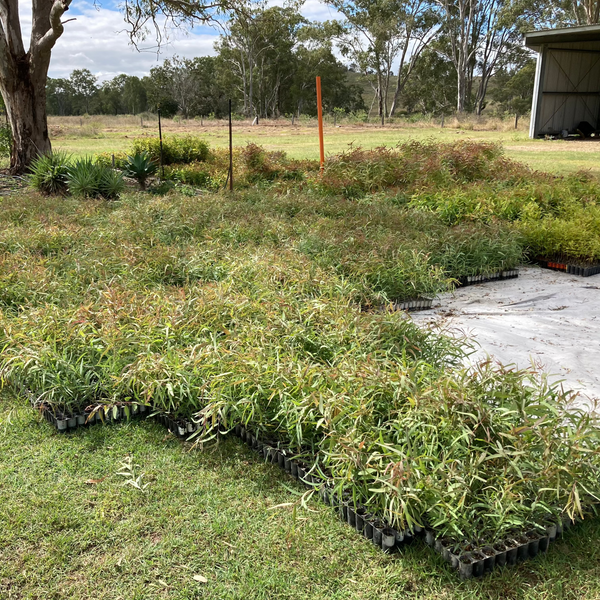Ivory Flat is one of four sites that make up Greenfleet’s Ivory Creek project, and is growing on Yuggera Country near Toogoolawah, a 2-hour drive from Brisbane, Queensland.
The reforestation of Ivory Flat will restore land previously cleared for cattle farming. As it grows, this forest will improve water quality and habitat connectivity along Ivory Creek which connects to the Brisbane River Catchment. Ivory Flat will also deliver other far reaching environmental benefits as it sequesters carbon.
This project is growing to extend habitat for koalas and Grey-Headed Flying Foxes, two species that are listed as endangered in Queensland.

Location & Map
The four forests making up Greenfleet’s Ivory Creek project are Ivory Flat, Cherry Avon, Browns and Avondale. They are being restored to connect with existing native forests on either side of the project. Together, these projects are delivering environmental benefits like the enhancement soil and water quality.
Our Ivory Flat property is growing between the Deer Reserve and Deongwar State Forests, and straddles Ivory Creek. Ivory Creek is part of the Brisbane River catchment so by restoring native forest along the creek this will improve water quality and reduce erosion.
The ecosystems present in this area prior to land clearing include Dry Rain Forest and Semi-evergreen Vine Thickets, which is endangered. Greenfleet’s revegetation and continued monitoring of these regional ecosystems will improve connectivity and support them as they develop for the rest of this century.
Ivory Flat is one of many Greenfleet projects delivering climate action through native reforestation in the South-East Queensland region. To see where some of our other native forests are growing, click here.

Revegetation Approach & Species Selection
Ivory Flat is being restored to provide habitat for existing koala populations. It will also extend the Dry Rainforest and Semi-evergreen Vine Thickets ecosystems found in this region.
This forest was planted in 2024, and our Revegetation Team will return over the coming years to monitor the project as it establishes.
To restore the native forest, Greenfleet has planted 24 locally native species which are creating a framework for the surrounding ecosystems to grow. This includes Kurrajong (Brachychiton populneus), a species which is now endangered in Queensland and found in the Semi-evergreen Vine Thickets ecosystem.
Other species planted include Australian Blackwood (Acacia melanoxylon), Moreton Bay Ash (Corymbia tessallaris), and Sandpaper Fig (Ficus opposita). The Sandpaper Fig is a fruiting plant that provides habitat and food sources for birds and insects, including the Purple Moonbeam Butterfly. Greenfleet’s revegetation also included eight eucalypt species, whose blossoms form part of the endangered Greater Glider diet.

Wildlife Habitat Restoration
This image (left) shows one of the koalas found in remnant vegetation at Greenfleet’s Ivory Creek project. With this species classified as endangered in Queensland, as well as New South Wales and the ACT, it is more important than ever to restore forests that support their feeding and breeding habits.
The devastating bushfires of 2019-2020 saw the loss of koala habitat and koalas in parts of Southeast Queensland and eastern Australia. Greenfleet has planted species such as Forest Red Gum (Eucalyptus tereticornis) at Ivory Creek, as this is a preferred species for koala populations. To support koalas and other threatened species, Greenfleet's forests are legally protected for up to 100 years, to safeguard koala habitat for future generations.
As well as expanding existing habitat for koalas, the native forest planted will benefit Grey-headed Flying-Foxes. These native bats are endangered due to habitat loss, and Greenfleet is planting eucalypts and other blossoming trees such as Pink bloodwood (Corymbia intermedia) and Creek apple (Angophora subvelutina) to provide for their diet of nectar and pollen.
Eventually as the forest flourishes, it may also attract endangered Greater Glider populations which are known to inhabit the region.

Climate Action
Greenfleet uses the Full Carbon Account Model (FullCAM) to measure the carbon uptake at our revegetation sites. This model was developed by the CSIRO and is approved by the Department of Climate Change, Energy, the Environment and Water.
The forest growing at Ivory Flat is legally protected for 100 years. Over that time, it will remove just over 68,000 tonnes of carbon from the atmosphere, which is the equivalent of what 15,813 average vehicles emit on Australia’s roads in a single year.
Location Size
113 hectares, 2 hours from Brisbane, Qld
Planting Dates
2024
Species
Hickory wattle (Acacia disparrima)
Maidens wattle (Acacia maidenii)
Blackwood wattle (Acacia melanoxylon)
Sally wattle (Acacia salicina)
Forest oak (Allocasuarina torulosa)
Creek apple (Angophora subvelutina)
Kurrajong (Brachychiton populneus)
River sheoak (Casuarina cunninghamiana)
Pink bloodwood (Corymbia intermedia)
Moreton bay ash (Corymbia tessellaris)
Small leaved white mahogany (Eucalyptus acmenoides)
Narrow leaved red ironbark (Eucalyptus crebra)
Silver leaved ironbark (Eucalyptus melanophloia)
Gummed topped box (Eucalyptus moluccana)
Grey gum (Eucalyptus propinqua)
Grey ironbark (Eucalyptus siderophloia)
Mugga ironbark (Eucalyptus sideroxylon)
Fores red gum (Eucalyptus tereticornis)
Sandpaper fig (Ficus opposita)
Brush box (Lophostemon confertus)
Swamp box (Lophostemon suaveolens)
Black tea-tree (Melaleuca bracteate)
Red bottle brush (Melaleuca viminalis)
White cedar (Melia azedarach)


